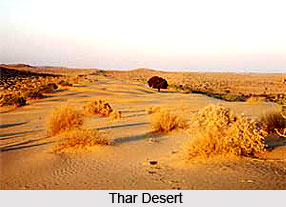 The deserts and xeric shrub-lands in India has been defined as a biome that is characterized by, relating to, or requiring only a small amount of moisture. The annual rainfall in the deserts and xeric shrub-lands is only ten inches or less, and the climate is arid or hyper-arid. The climate is characterized by a strong moisture deficit, where annual potential loss of moisture from evapotranspiration well exceeds the moisture received as rainfall. These lands usually occur in tropical, subtropical, and temperate climate regions and the soil in them tends to be sandy or rocky, and low in organic materials. The common types of soils in these lands include the saline or alkaline soils.
The deserts and xeric shrub-lands in India has been defined as a biome that is characterized by, relating to, or requiring only a small amount of moisture. The annual rainfall in the deserts and xeric shrub-lands is only ten inches or less, and the climate is arid or hyper-arid. The climate is characterized by a strong moisture deficit, where annual potential loss of moisture from evapotranspiration well exceeds the moisture received as rainfall. These lands usually occur in tropical, subtropical, and temperate climate regions and the soil in them tends to be sandy or rocky, and low in organic materials. The common types of soils in these lands include the saline or alkaline soils.
The deserts and xeric shrub-lands in India, houses several species plants and deserts that are adapted to low moisture conditions. The hyper-arid regions of these shrub-lands are mostly devoid of vegetation and animal life, and also include rocky deserts and sand dunes. The vegetation in arid climate regions can include sparse grasslands, shrub-lands, and woodlands. The plants that are adapted to arid climates are known as xerophytes, and they include the succulent plants, geophytes, sclerophyll, and annual plants. The animals commonly found in these shrub-lands include the insects, reptiles, arachnids, birds and mammals.
The deserts and xeric shrub-lands in India include four regions like the Deccan thorn scrub forests, the Indus Valley desert, the Northwestern thorn scrub forests, and the Thar Desert. The Deccan thorn scrub forests, is actually a xeric shrub-land ecoregion of India. This shrub-land covers the arid portions of the Deccan Plateau, extending across the Indian states of Maharashtra, Karnataka, Andhra Pradesh, and Tamil Nadu. The Indus Valley desert is a desert ecoregion covering an area of 19,500 square kilometers. The desert is located in the northwestern Punjab Province, and lies between the Chenab and Indus rivers. The Northwestern thorn scrub forests are surrounding the desert. However, compared to the Northwestern thorn scrub forests, the Indus Valley Desert is drier and less hospitable.
The Northwestern thorn scrub forests are the xeric shrub-land ecoregion of northwestern India. The ecoregion encircles the Thar Desert and Indus Valley Desert eco regions and includes the western half of Gujarat (excluding the mountain of Girnar). The forests are extending through Rajasthan, where they are bounded on the southeast by the Aravalli Range. The Northwestern thorn scrub forests, encompasses most of Haryana and Punjab states of India and also the Jammu region of Jammu and Kashmir, extending to the foothills of the Himalayas. The Thar Desert is another region included in the deserts and xeric shrub-lands in India. The desert is a large, arid region in the northwestern part of the Indian subcontinent and has an area of more than 200,000 sq. km. It lies mostly in the Indian state of Rajasthan, and extends into the southern portion of Haryana and Punjab states and also into northern Gujarat state.















